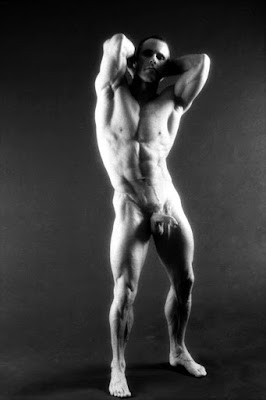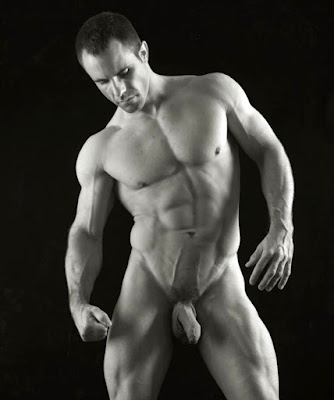

A review of the male nude in classical sculpture and how times have changed.

So, first of all, we'll give props to peeps like Michelangelo and Rodin, but we should probably have a little discussion about the Greeks to start us off.
You remember the Greeks. They were the guys (and it was mostly guys--women at the time were mainly relegated to childbearing and housekeeping or sex objecthood, and were seldom heard from) who pretty much invented what we now think of as Western civilization. Their ideas about culture and society, which the Romans copied, influence us to this day.
The Greeks also . . . well, we'll get into a discussion of Greek sexual preferences some other time. For now let's just say they were fascinated by male beauty, and in particular by (sigh) the penis.
The Greeks weren't shy about displaying their manly attributes. Nudity was celebrated in Greece as in no culture before or since. We're so used to nude classical sculpture and painting that we figure that's how everybody walked around back in those days. In fact, however, male nudity in art and among athletes and warriors was largely confined to the ancient Greeks, for whom it became a point of pride--they considered embarrassment at having to disrobe for sports a sign of barbarism. Admiration of the manly form at times verged on the cultlike; the more heroic bits of male sculpture, small penis or no, have an erotic charge that can make even a straight male sweat.

Naked women were depicted too, but less often, and you sometimes get the feeling the artist's heart wasn't in it.

The penis shows up in Greek art a lot--big ones as well as small ones. For example, there's the temple of Dionysus on the island of Delos, which features giant stone penises carved in the third century BC. Decapitated now, they're still impressively scaled and in a state of salute. (The academic term describing this condition, incidentally, is ithyphallic.)
Sculptural depictions of the erect penis were an everyday sight in the classical world. A common boundary marker and household totem in ancient Greece was the herm, originally a representation of the god Hermes. It consisted of a head on top of a simple squarish pillar--your basic supersized Pez dispenser--unadorned except for, in front, an amply proportioned, usually erect, and sometimes arrestingly protrusive penis and scrotum. Scholars tell us that such decorations were apotropaic (you learn a lot of vocabulary in this field)--that is, intended to ward off evil, and that folks back then paid no more attention to them than we would to a lucky horseshoe.
Maybe, all I'm saying is, stuff that even now we'd consider hard-core porn you saw then just walking down to the Piraeus.
The ancients were also unembarrassed by graphic displays of sex. Greek men--to be precise, male Greek aristocrats--figured if it moved, they could have sex with it, or at least look at pictures about having sex with it.
We have countless examples of crockery showing various combinations of humans, deities, and the occasional animal engaged in the amatory act, most of it presumably used as party favors to put the lads in the mood. Even in painterly scenes having nothing to do with sex the genitalia were often conspicuously displayed.
From this vast array of XXX-rated artwork we can make a few deductions about Greek aesthetic preferences, genitalia-wise (here I mainly follow Kenneth Dover's landmark study Greek Homosexuality, 1978):
(1) Long, thick penises were considered--at least in the highbrow view-- grotesque, comic, or both and were usually found on fertility gods, half-animal critters such as satyrs, ugly old men, and barbarians. A circumcised penis was particularly gross.
(2) The ideal penis was small, thin, and covered with a long, tapered foreskin. Dover thinks the immature male's equipment was especially admired, which may account not only for the small size but the scarcity of body hair in classical art.
You're thinking: How times have changed. Ain't arguing. Of course, we do have to take into account a contributing factor: artists' models were nude, and their studios lacked central heat.



















































